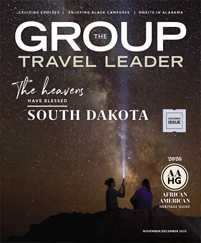Fort Smith, Arkansas, is a time capsule containing all the romance and danger of the Wild West — and it’s waiting to be unearthed by groups.
Situated at the confluence of the Arkansas and Poteau rivers in the valley between the Ozarks and the Ouachita mountains, Fort Smith was founded in 1817 by the U.S. Army and incorporated in 1842. It played a key role in many important eras of American history, including the Mexican-American War, the Civil War and the American Frontier.
But its Old West history is arguably its biggest draw. For many years, it was the gateway to unsettled “Indian Territory,” i.e. present-day Oklahoma, following the Indian Removal Act. The rugged settlement was home to all the staples of the Wild West, from outlaws and bounty hunters to gallows and brothels. History buffs will have lots more to learn because, later, Fort Smith yet again became an important military site for the U.S. in the years leading up to World War II.
Its patchwork of colorful history will draw groups in, but Fort Smith’s culture of hospitality will keep them coming back. With a diverse array of group-friendly restaurants, outdoor recreation, and arts and cultural attractions, this frontier town has plenty to entertain its visitors in between stops at its abundant historic sites.
Fort Smith National Historic Site
Many of Fort Smith’s most popular attractions involve its role in frontier history, including the Fort Smith National Historic Site. The historic area has several major draws throughout its 37 acres, including Judge Parker’s Courthouse and courtroom, where one of Fort Smith’s most famous figures, Judge Isaac Parker, nicknamed “the Hanging Judge,” oversaw the trials and sentencing of dozens of men. Visitors can also see the gallows, where many of the men sentenced by Parker met their fate.
Fort Smith and Judge Parker have been popularized in pop culture, including in Western films such as “True Grit” and even in more recent television depictions.
“We noticed that there was increased interest in the Judge Parker story because he was featured in the ‘Lawmen: Bass Reeves’ miniseries that Taylor Sheridan produced,” said Olan James, experiences manager at the Fort Smith Convention & Visitors Bureau.
The historic site also contains a history museum and the Trail of Tears Overlook, which features exhibits about the Trail of Tears and the forcible removal of Indigenous tribes from the Southeast. Fort Smith was a notable stop as one of the last pieces of federal land before entering the territory.
U.S. Marshals Museum
A newer addition to the town’s study on Wild West history is the United States Marshals Museum, which opened in 2023 after 16 years of planning and fundraising. Fort Smith was chosen as the home of the museum by the U.S. Marshal Service because more marshals and deputy marshals perished in frontier-era Fort Smith than any other location in their history.
Located on the banks of the Arkansas River, the museum layout is a modified star shape to symbolize the badge worn by the U.S. marshals. Its innovative design features plenty of floor-to-ceiling windows. Inside, five galleries immerse visitors in the history of the marshals through distinct eras of American history, from the late 18th century to present day. The galleries include interactive exhibits and historic artifacts, and the museum also features a memorial wall to honor marshals who died in the line of duty.
“The United States Marshals Museum does a really good job of depicting the history of the marshals from the time of their inception all the way throughout history,” James said. “The marshals were involved in integration, and a lot of people are not aware of that. They were involved with Ruby Bridges and protecting her and helping guide her into the school.”
The museum offers bus parking and reduced rates for visiting groups of 10 or more.
Miss Laura’s Brothel Museum
In 1898, a woman named Laura Ziegler commissioned a large building in downtown Fort Smith, not far from the Arkansas River. She opened it as a brothel in 1903, and it continued to operate as a brothel until 1948. This colorful piece of Fort Smith’s past has been meticulously preserved and is now known as Miss Laura’s Brothel Museum, a popular attraction for all travelers visiting Fort Smith.
Inside, the Victorian building has been set up to reflect how it would have appeared during the early 20th century with period furnishings. Personal artifacts, photographs and exhibits tell the story of the women who worked there and the impact they had on Fort Smith as a whole.
“It tells the story of these women and their profession from a very respectful perspective,” James said. “People have to understand that history because it was an important part of women’s history that should not be forgotten.”
Groups of 15 of more can enjoy a discounted group rate and should schedule a private tour of the museum in advance.
Fort Chaffee
Beyond its role in Old West history, Fort Smith has long been a place of military significance. Camp Chaffee, founded in 1941 to meet the training and armory needs of the U.S. military, is now a historic district. It was renamed Fort Chaffee and functioned as a German prisoner-of-war camp and, later, as a site for housing Vietnamese, Cambodian and Cuban refugees.
The Chaffee Barbershop and Military Museum was recently expanded. It honors the historic site’s long legacy of military significance with educational exhibits in a space restored to its 1958 appearance. It also commemorates Elvis Presley’s “haircut heard ’round the world,” which occurred when Presley was inducted into the Army in the late 1950s. Admission to the museum is free.
Today, the historic district of Fort Chaffee combines the World War II-era buildings with modern additions of shops, restaurants and entertainment venues. It’s also sometimes used as a film set.









